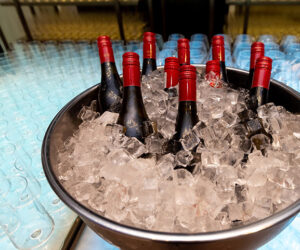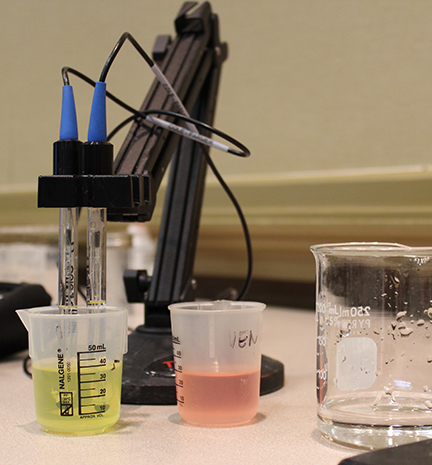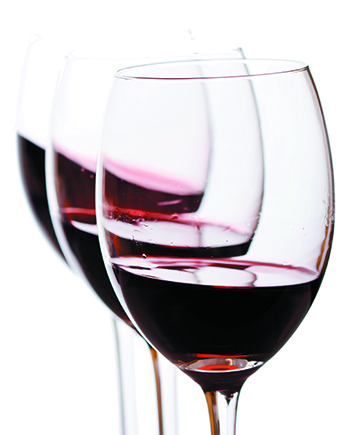
In previous articles on phenolics I have reviewed the basic structure of the most important phenolic compounds in wine production and discussed how different processing and equipment options can impact the type and quantity of phenolics in finished wines. In this article we will explore the additives and fining agents common in commercial wine production and available to home winemakers. These tannin additives and fining compounds may be used to modify the quantity of different phenolic species, and thus impact the color, bitterness, and astringency of the treated wine.
Before we begin this discussion, I should probably take a moment to center the discussion around current trends in consumer perception of wine production and how that may impact actual production practices. The natural wine movement has seen explosive growth in popularity in the last decade despite the fact that a strict definition of what actually constitutes natural or “unnatural” wine has not been agreed upon by the disparate interests that promote these wines. One positive outcome of this movement, and a general trend in the overall food industry regarding “clean labeling,” is that many commercial winemakers now question whether the additives they employ in wine production are really necessary. I think nearly everyone who produces wine shares the philosophy that the goal of wine production is to produce interesting and high-quality wines while utilizing the least amount of additives. Still, there are times where judicious use of additives or fining agents can increase the quality of the wine produced, especially when weather or harvest difficulties have left us with less than ideal fruit. Let’s introduce the different additives and fining agents in general, then investigate how these additives and fining agents are used in white and red wine production.
Tannin Additives
Tannin additives offer options for increasing the tannin level at various points in the winemaking process, from use as an anti-oxidant and color-stabilizing additive on the crush pad to adjusting the mouthfeel and astringency level of finished wines prior to bottling. The word “tannin” is an umbrella term for a whole range chemical compounds found in many different plant species.
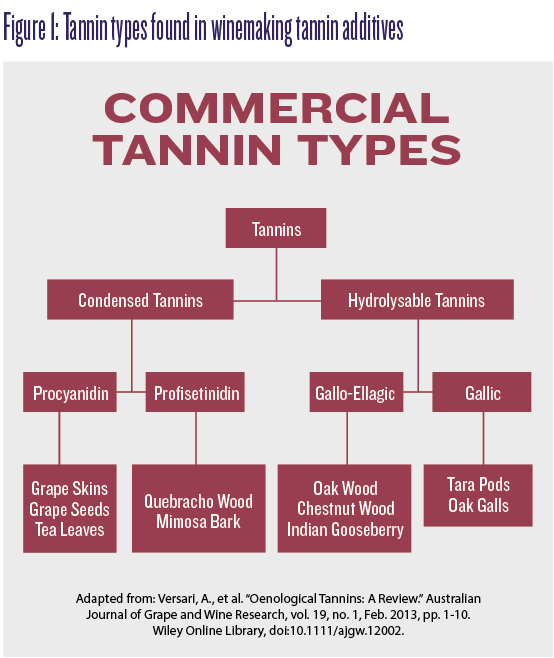
Figure 1 shows some of the possible sources of tannin used in commercial winemaking tannin additives. It seems obvious that grape skin and seed tannin and also oak wood-derived tannin should be on this list, but why would additive suppliers offer products made with quebracho wood or oak galls? The reason is that tannins from grapes and oak tend to be expensive due to the quantity of tannin in these materials and the processing required to extract and purify them. On the other hand, the extraction of tannin from other plant sources is more economical.
In general, it is believed that hydrolysable tannins aid in antioxidation activity and also add to the mouthfeel character (often described as mid-palate fullness) of wines. Thus these types of tannin are often recommended for white wines to limit oxidative browning and add to mouthfeel. They may also be used in fruit damaged by Botrytis in order to bind and remove laccase from must. Laccase is an enzyme that is stable in wine and can cause browning and filterability problems. The role of hydrolysable tannins themselves in the promotion of color stability is still unclear, but it has been shown that adding oak extracts (which contain hydrolysable tannin and other compounds) to young red wines can increase color stability.
The condensed tannins from grapes also work both as antioxidants and interact with anthocyanins to promote polymeric pigments and long-term color stability. Like hydrolysable tannins, condensed tannins also alter mouthfeel and astringency, with the impact on taste dependent on the size of the tannin polymer.
Many commercial producers of tannin additives offer propriety blends of tannins from several different plant sources. Producers also offer 100% grape-based tannin as well as 100% oak wood-derived extracts. The idea behind these tannin blends are to offer an economical and targeted tannin product for a particular point or purpose in the winemaking process. Thus tannin additives are often marketed in terms of the winemaking timing where they should be added. Fermentation tannins are utilized during crushing, pressing, and fermentation. Cellaring tannins are designed for use after fermentation and pressing are complete, often in conjunction with the micro-oxidation that occurs during barrel aging. Finishing tannins are designed as a final small astringency adjustment, or to add a bit of oak-derived fullness to a wine just prior to bottling.
Enzymes
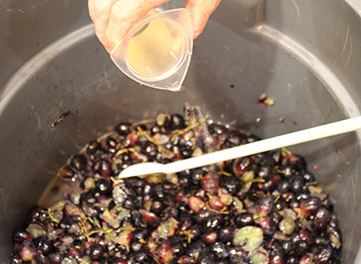
Using enzyme additives during crush and fermentation has been shown to increase both color and tannin content in red wines.1 Enzymes, like tannin additives, can be hard to choose as there are many different enzyme preparations offered by suppliers. It’s important to understand that enzymes are catalysts; they are not a substrate for a chemical reaction, but they make particular chemical reactions happen much more quickly than they would without the enzyme. Most enzymes have a fairly restricted number of substrate reactions that they catalyze, thus enzyme suppliers tailor enzyme types and blends in their products to perform specific functions. In wine production, enzymes are used to increase yields in white and rosé wines during pressing, to increase the extraction of aroma compounds in white musts prior to pressing, to aid in clarification and settling of musts, and to increase the extraction of phenolic compounds (both color and tannin) in red wine production. Enzymes most often work best when added directly after grape crushing.
Fining Agents
Fining agents are additives that have an affinity for a target chemical compound in a juice or wine. Most fining agents have limited solubility (don’t dissolve easily) in juice or wine, so they are easily removed from the wine, along with the target compound they have attracted. Previous articles in this magazine have given a good overview of the different classes of fining agents and their target compounds. There are also some excellent resources on the internet with regard to fining agents. The Australian Wine Research Institute (AWRI) provides a good overview here: https://www.awri.com.au/industry_support/winemaking_resources/frequently_asked_questions/fining_agents/, as does Washington State University here: http://pubs.cahnrs.wsu.edu/publications/pubs/em016/.
In terms of phenolics, the most important class of fining agents are the proteins, and the protein-like polyvinylpolypyrrolidone (PVPP). Protein-based fining agents attract tannin molecules because they contain ring-stabilized oxygen atoms that are usually slightly positively charged in wine solutions. These oxygen atoms are attracted to the many ring-stabilized hydroxide units (slightly negatively charged) in tannin molecules.
Common proteinaceous fining agents in winemaking include: Casein, albumin, isinglass, and gelatin. Suppliers of these fining agents offer purified forms of these compounds and may also modify them to change their size distribution and/or make them slightly easier to incorporate into wine. Some suppliers also offer propriety blends of these fining agents combined with other fining agents like bentonite with the goal of improving clarity at the same time as removing bitter or browning agents, and eliminating the possibility of over-fining. Two other fining agents often used to lower phenolic levels in wine are PVPP and activated carbon. PVPP is a plastic polymer, but it has a very similar chemical structure to the active part of the proteins mentioned earlier. Activated carbon is a compound with a tremendous surface area-to-volume ratio, and as such acts as a general attractant to a large number of chemical compounds. Activated carbon for winemaking is usually sold in two types, one designed for reducing color and the other designed for reducing unwanted aromas. The decoloring carbon should be used if color adjustment is needed, but even decolorizing carbon will impact aromas so it is often used as a last resort.
As a general rule protein-based fining agents attract polyphenolic compounds of similar size. Small phenolic molecules are thought to contribute bitter taste to wine, while larger phenolic polymers correlate with the perception of astringency. Color molecules and browning precursors are generally smaller molecules, especially at crush and during fermentation before they have a chance to be incorporated into polymeric pigments. The size range of fining agents for phenolics from smallest to largest is: PVPP, casein, albumin, isinglass, and gelatin.
As a final thought, you may have noticed that the classic proteinaceous fining agents are all produced by, or products of, animals. Due to concerns about the sources of these compounds and the increasing interest in producing vegan wines, several additive suppliers have obtained regulatory approval for proteinaceous fining agents made from pea or potato protein. Winemakers report that these products work well, although I have heard complaints about aroma changes when these new fining agents are used at high rates, so benchtop trials, our next topic, are important.
Importance of Benchtop Trials
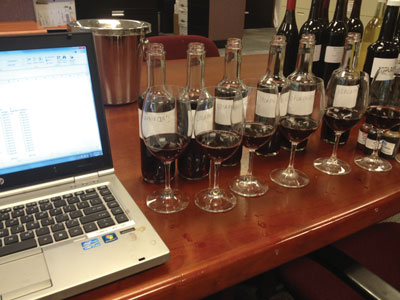
Manufacturers of tannin additives and fining agents provide standard and maximum dosage rates for their use. If you are unfamiliar with how these products might impact the juice or wine, or when it is difficult to perform a trial (enzyme additions on must are difficult to trial, for instance), using the manufacturer-recommended rates is appropriate. Still, it is difficult to predict exactly what organoleptic impact a given tannin product or fining agent will have on the aroma, bitterness, color, or astringency of a specific juice or wine, and there is a definite risk in adding or removing too much tannin or color from a wine. Therefore, winemakers often perform benchtop trials to determine which additive has the most beneficial impact and what addition rate yields the optimum result. In order to perform a trial you will need enough base juice or wine to set up a number of different additives and a range of additive rates, as well as the additives you would like to trial and a method of weighing or measuring relatively small masses and volumes. You will also need to smell and taste through all your samples, so having a well-organized and aroma-neutral space for performing the trial is important. Also having someone else, or a small group if possible, smell and taste with you is always beneficial as other tasters may pick up something you missed or reinforce your own sensory observations. Plus, tasting wine together is always more fun!
To calculate the quantity of additive to add to the benchtop sample volume that will correspond to the addition rate range of your additive trial you will need the assistance of a spreadsheet calculator or an online resource. If you are spreadsheet and math averse a simple calculation sheet from Enartis is available here: https://www.enartis.com/wp-content/uploads/2019/04/Lab-Bench-Trials_17.pdf. AWRI also has a more complex online fining trial calculator that allows you to enter a couple of range parameters and the sample volume. It produces a chart of the addition rates based on the sample volume and can be found here: https://www.awri.com.au/industry_support/winemaking_resources/calculators/fining-trial/
White, Sparkling, and Rosé Production
Since phenolic concerns in white, sparkling, and rosé production are quite similar we’ll discuss these wine styles at the same time. In white wines it is most common that phenolic compound levels need to be reduced, thus fining agents are employed to bind with and remove phenolic compounds. While uncommon, there is at least one reason for using tannin additives in white wine production, and that is in the case of mold-damaged fruit with Botrytis infection. I covered the most common fining agents in “Phenolics & Tannins in White, Sparkling, and Rosé Styles” from the June-July 2020 issue, but we’ll summarize that information again here for quick reference.
PVPP is often used in white wine production to limit browning and pinking color precursors, as well as to remove bitterness (often in combination with another protein-based agent like casein or gelatin), and as a clarification aid. PVPP is a pretty gentle fining agent (doesn’t impact aromas) and is easily removed from wines with filtration. Casein and gelatin are also commonly used in white wine production to remove browning agents, lessen the bitterness and astringency profile, and as a clarification aid.
Casein is thought to be gentler than gelatin and is easily removed from wine, but it is so slightly soluble that it can be difficult to incorporate into the liquid. Some commercial formulations modify the casein with potassium to make it easier to dissolve.
Gelatin is better at removing larger tannin molecules than smaller ones, so it is often employed to reduce astringency. Using too high a dosing rate of gelatin can impact the aroma and leave gelatin in the wine, so fining trials are important and some winemakers counter fine the gelatin with bentonite or silica gel to ensure all the gelatin is removed. Winemakers often use these fining compounds prior to fermentation because they believe the potential aroma impact is lower at the juice stage, but it is also possible to use these fining compounds after fermentation is complete.
Isinglass has a relatively low impact on phenolics and is therefore added more to eliminate haze and promote clarity in whites than to impact bitterness or astringency.
Red Wines
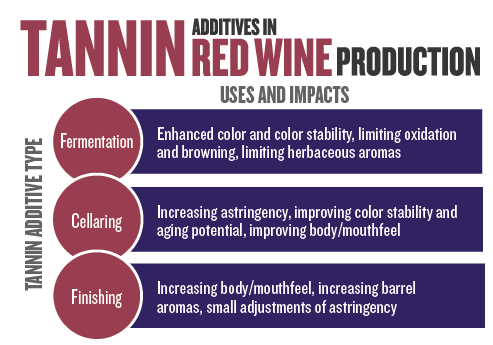
Red wines can have problems of not enough, or too much, tannic astringency. Red wines may also have issues with browning. Because different additives have impacts in different stages of the winemaking process for reds, we’ll discuss common additives at each stage.
Crushing and Fermentation:
As we mentioned earlier, enzymes that break down skin cells have been shown to increase anthocyanins and tannins in the finished wines. These are usually added at the crush pad and work their magic prior to and early in fermentation. Fermentation tannins may also be added at the crush pad and can serve three important purposes. First, they can limit oxidation of other critical components in the juice for red musts with low tannin levels and those that may be impacted by mold. Grape-based tannins or tannins from other plant sources may be used for this purpose. Second, they can kick start the process of anthocyanin and tannin integration for producing stable color. Third, they can add tannin to begin building the tannic structure that leads to the astringency of the finished wine. Grape-based tannins are utilized for these benefits.
There is a caveat to building tannin structure early when working with hybrid grapes. Hybrids have been shown to have more and different proteins than vinifera varieties, and research has shown that standard tannin addition rates prior to pressing did not seem to increase the tannin level in the finished wine.2 For this reason it may be more prudent to add tannin during cellaring to increase astringency for hybrid wines. Some producers also market their products as having the ability to lower herbaceous aromas in under-ripe fruit. I haven’t seen research evidence of this impact but I’ve heard several commercial winemakers state that this is one of the reasons they use these products. Wood-based tannins are often used for this purpose. Thus commercial tannin suppliers often develop tannin blends from different sources to support a range of stylistic goals in the fermentation stage.
Cellaring and Aging:
Once fermentation is complete and the wine has been pressed off the skins, cellaring and aging tannins may be employed. Grape-based tannin additions at this point help build tannin structure for grapes with limited tannin, as well as continuing to integrate anthocyanins into tannin structure for color stability. Wood-based tannins may also be added during cellaring to add body and increase the mouthfeel of young wines. The traditional method of adding wood tannin is the use of new or almost-new barrels. Barrel alternatives like chips and staves are also a popular method of adding wood tannin. Commercial wood-based tannin preparations are thus a continuation of the innovation of using chips and staves. Cellaring tannins may be 100 percent sourced from grape or oak wood, or may be a combination of wood and grape tannin to promote the goals mentioned above. It can be a little difficult to judge how tannin additions during cellaring will impact the wine after aging, so a measured approach to additions over the course of several vintages, or setting up trials with different lots of wine to judge the impact, is a prudent approach.
I can’t think of a reason a winemaker might want to decrease color in a red wine, but during the cellaring and aging of reds a winemaker may decide that the bitterness or tannin profile needs to be decreased. Egg whites, whose primary protein is albumin, is a very traditional method of reducing astringency in red wines (it is not recommended in whites due to the potential for protein instability). Gelatin is also a popular fining agent for reds to reduce bitterness and astringency. Details on the use of these fining agents may be found in the references at the end of this article.
Finishing:
Finally, finishing tannins are designed to tweak the tannin profile or add some body and fullness to a wine just prior to bottling. These tannins are often wood-based and may also alter the aroma of the wine slightly to give it a bit more oak-derived polish. Benchtop tannin trials should definitely be performed with tannin additions prior to bottling to guard against a dramatic change in aroma, mouthfeel, or astringency that might overpower the other components in the wine.
A Final Word on Balance
We’ve discussed how the phenolic profile of wines impact taste and mouthfeel as well as ways to adjust anthocyanin and tannin content in the cellar, both with processing choices and the use of additives. As a final thought it’s important to understand that wine phenolics are found in a complicated matrix of water, alcohol, acid, polysaccharides, proteins, aroma compounds, and perhaps sugar, all of which impact how we perceive bitterness, astringency, and body in wine. So, besides changing the actual tannin content in wine it is also possible to adjust astringency perception by changing the acid level, sugar and alcohol content, and body of the wine. Higher acid levels increase the perception of bitterness and astringency. Higher sugar and alcohol levels, as well as increased body, decrease the perception of astringency. Adding a bit of residual sugar to wine at bottling is a well-known tool to take the edge off both high acid levels as well as bitterness and astringency. Blending is also a traditional method of achieving balance in wine by combining together the elements of separate wines that, when brought together, make a more balanced whole. There are other winemaking additives that impact the body of wine, such as polysaccharides, gum arabic, and mannoproteins. As in all aspects of winemaking, there are a lot of options and no single one is the correct way to make a pleasant, balanced wine. That’s part of what makes winemaking so enjoyable.
References
1 Soto Vázquez, E., Río Segade, S., & Orriols Fernández, I. (2010). “Effect of the Winemaking Technique on Phenolic Composition and Chromatic Characteristics in Young Red Wines.” European Food Research and Technology = Zeitschrift für Lebensmittel-Untersuchung und -Forschung, 789–802.
2 Manns, D. C. (2013). “Impact of Processing Parameters on the Phenolic Profile of Wines Produced from Hybrid Red Grapes Maréchal Foch, Corot noir, and Marquette.” Journal of Food Science, vol. 78, no. 5, pp. C696–702.



